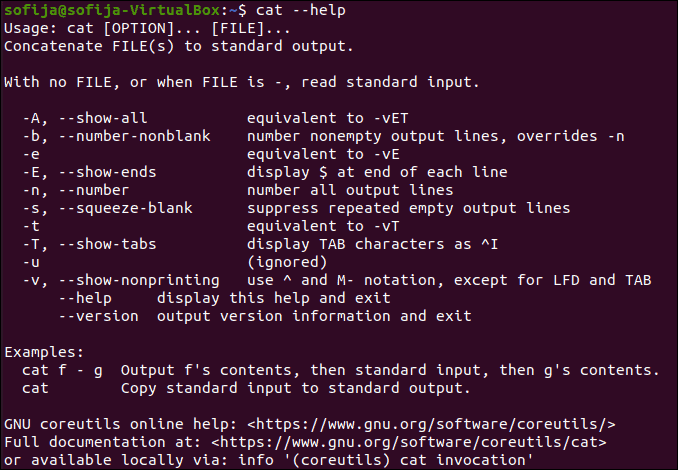Introduction
If you have worked in Linux, you surely have seen a code snippet that uses the cat command. Cat is short for concatenate. This command displays the contents of one or more files without having to open the file for editing.
In this article, learn how to use the cat command in Linux.

Prerequisites
- A system running Linux
- Access to a terminal window / command line
cat Command Syntax
To use the cat command, follow the format:
cat [options] filename(s)[options] – This lets you issue additional instructions to the cat command. For example, to display the contents of a file with each line numbered, use the –n option:
cat –n filenamefilename(s) – Specify the name of the file (or files) that you want to display. If you use more than one filename, each file will be displayed.
Linux Cat Command Examples
This article includes 15 cat commands and examples of how to use them. To try out the commands, create a couple of sample files, and test the cat commands listed below.
1. Create a New File
You can create new files and add content to them using the cat command.
Create test1.txt and test2.txt, which you can use as sample files to test out the other commands.
1. Open a terminal window and create the first file:
cat >test1.txt2. The cursor moves to a new line where you can add the wanted text. Type a simple sentence such as:
This is test file #1.3. To exit the prompt and write the changes to the file, hold the Ctrl key and press d.

4. Repeat the process to create test2.txt. Run:
cat >test2.txt5. Type:
This is test file #2.6. Press Ctrl+d.

2. Display Contents of a Single File
To display the contents of test1.txt using the cat command run:
cat test1.txtThe output displays the content as in the image below.

3. Display Contents of Multiple Files
To display the contents of both files, run the command:
cat test1.txt test2.txt
4. Redirect Contents of a Single File
Instead of displaying the contents of a file on the screen, cat can put them in a file.
cat test1.txt > test3.txtIf the destination filename doesn’t exist, it will be created. If you run cat on test3.txt, you should see the contents from test1.txt:
cat test3.txtThe output displays:

If a file is exported that already exists, this will overwrite the contents of the file:
cat test2.txt > test3.txtcat test3.txtThe test3.txt file now has the following content:

5. Redirect Contents of Multiple Files
You can redirect the contents of multiple file into one single file:
cat test1.txt test2.txt > test3.txtDisplay the content of test3.txt with:
cat test3.txtThe output shows the contents of both files, as in the image below.

6. Display the Contents in Reverse Order
The cat command can display the content of a file in reverse order (by lines). To do this, use tac (cat in reverse):
tac test3.txt
7. Append File Contents to Another File
The cat command can add the contents of a file to the end of another file. Instead of using a single > sign, use a double >> sign:
cat test1.txt >> test3.txtOpen the test3 file by running:
cat test3.txtThe content of test3 followed by test1 should display.

Note: If you want to remove the sample files, take a look at how to remove files and directories using the Linux command line.
8. Append Text to Existing File
You can use a similar command to append text to an existing file:
cat >> test1.txtAdd a new line to the file:
This is the second line in test file #1.Hold Ctrl and hit d.
Check the content of the test1.txt file:
cat test1.txt
9. Combine Operations
The functions of the cat command can be combined. For example, to combine the output of two files, and store the result in a new file:
cat test1.txt test2.txt > test4.txtcat test4.txt
Alternately, you can append multiple files to the end of an existing file:
cat test2.txt test1.txt >> test4.txtcat test4.txt
Note that the order specified is the order the files in which they are added to the destination file.
Note: Once you have created multiple files, you may want to group them in a single directory. Take a look at how to use mkdir command to make or create a Linux directory.
10. More and Less Options (Manage Large Files)
If you use cat on a very large file, you’ll end up with a huge string of data that’s hard to read. You can break it into pages using | more:
cat test4.txt | moreThis displays a single page of the file. When you press a key, it will scroll to the next page.
If you’d like the ability to scroll forward and backward through the display, use | less.
cat test4.txt | lessNote: Learn how to use the Linux split command to easily manage text files with many lines.
11. Show Line Numbering
You may find it useful to have line numbers in the output, especially for large files. To enable line numbering, add the -n option to the cat command:
cat –n test1.txtThe output should appear as in the image below:

12. Show the End of Line
You can instruct cat to highlight the end of each line and spaces between lines with $.
To do so, use the command:
cat -e test1.txtSince the sample file test1.txt has only one line, the output shows one $ at the end of it.

13. Show TAB Separated Lines
The cat command has the option of displaying the file content along with the tab space within the text.
To show tab separated lines for a sample run:
cat -t test4.txtThe tab space within the text is represented by ^I.
14. Remove Blank Lines
To omit blank lines from the output of cat with the –s option:
cat -t test4.txt15. List All CAT Commands
If you have trouble remembering the options, use the --help command:
cat ––help
Note: Learn how to concatenate strings in Bash.
Conclusion
You should now have a good understanding of how to use the cat command in Linux.
Want to master more Linux commands? Check out our list of Linux Commands All Users Should Know.